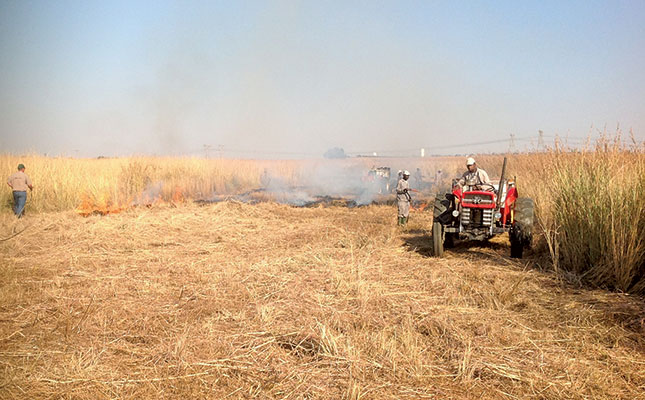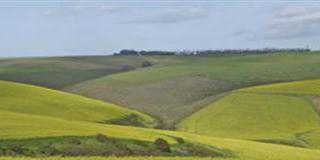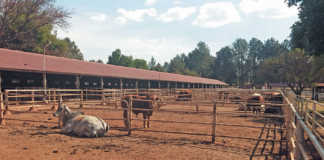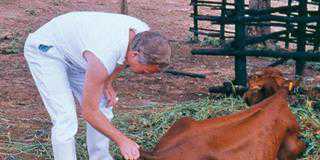
Photo: FW Archive
Landowners and farmers are often skeptical that firebreaks can stop a wildfire. Given reports of fires jumping national roads, and the number of fires started by random striking of lightning, they question how wide a firebreak would need to be to stop a fire.
These are valid concerns. However, it is important to define the actual role of firebreaks. Most importantly, their function is to create safe (or black) zones from which to initiate backburns in order to stop a wildfire in its tracks. If a firebreak is substantial enough, it may even become a safe zone for livestock during wildfires. However, there is no set or standard width for an effective firebreak.
Environmental factors determine exactly how wide a firebreak should be. These include the type and state of the vegetation, the quantity of grass fuel load present and the grass curing (the percentage of dry matter in the sward) at the time of construction.
South Africans generally have a poor understanding of the role played by weather in fire behaviour.
When burning firebreaks, landowners should be cognisant of high temperatures, low relative humidity and even moderate wind speeds, all of which are cause for concern during prescribed burning. High grass fuel loads, especially dry grass with a high curing percentage, exacerbates fire behaviour.
When to burn firebreaks
Prescribed burning and the construction of burned firebreaks should be done only on days with a low Fire Danger Index (FDI) – that is, days coded green and/or lower yellow. It is also advisable wherever possible to burn during the cooler hours of the day – before 10am and after 4pm. Labour permitting, the safest time to burn a hazardous firebreak is usually in the early evening after sunset.
How to make a firebreak
There are six commonly used methods to burn a firebreak:
- A wet line firebreak: This is made using knapsack sprayers to dampen the grass with water in parallel lines on the outer edges of the proposed firebreak. The dry grass in between is then burned. The wet line firebreak is constructed progressively over short distances of approximately 10m so that the sprayed grass does not have time to dry out before the area in between has burned out.
- A dry line firebreak: This is created by igniting two parallel lines of fire, about one metre apart, for a distance of approximately 10m. The flames are drawn towards each other, thereby lessening the heat for fire fighters beating out any flames spreading into the surrounding grassland. Once the first section has been successfully burned the next 10m can be lit. This is a slow but effective method of constructing firebreaks in areas of limited water supply. Two lines of burned firebreak can be prepared in this manner 50m or 100m apart to create safe edges from which to ignite the main firebreak. Once the outline borders have been completed, the area in between the lines can be burned.
- Herbicides: These should be sprayed in parallel lines 5m to 10m apart in early autumn. Once the sprayed canopy leaves of the grass sward have suffered a topkill the unburned section in-between can be burned later in the season to form the firebreak.
- The Botha fire-box: Developed by Andries Botha in the Adelaide district of the Eastern Cape, this is a very safe technique that can be used to burn firebreaks under windy conditions. Its chief disadvantage is that it is slow to burn a firebreak this way and it is therefore unsuitable for extensive firebreaks.
- Open-ended firebreaks (OEFB): This innovative method involves dropping aerial ignition capsules from a helicopter. It is cost-effective for constructing firebreaks over extensive distances, and is especially suitable in wilderness areas and inaccessible mountainous landscapes.
Weather conditions must be suitable when using this method, but on the other hand, the simplicity and speed of the technique allows the farmer to take advantage of a small window of opportunity.
For this method, the temperatures must be below 25°C, relative humidity below 50% and wind speed not above 8km/h – that is, the FDI code must be green. Grass curing must be 30% to 40% and the grass fuel should preferably be two years old.
Firebreaks should be ignited in the cooler temperature of late afternoon autumn, when relative humidity is increasing and the windless likely to be problematic. On a clear, cloudless night (cloud cover <20%), dew extinguishes the fire in the early evening. In frost-prone areas, OEFBs can be burned later in the season as the frost extinguishes the fire.
This was tested during June 2014 in the Matatiele District in KwaZulu-Natal, where communities living between Ongeluksnek and Quachasnek are threatened each year by wildfires. Working on Fire successfully ignited a 62km firebreak at an altitude of about 1 800m in 40 minutes using ignition capsules.
An OEFB between 200m and 500m wide was burned in this highly inaccessible terrain with a minimum of effort in just a few hours. The fire was ignited at 2pm and extinguished by frost at 11pm.
Adapting this technology for ground crews has proved highly successful, provided weather conditions are optimum. It is essential to obtain a five-day weather forecast in order to plan firebreak construction under safe weather conditions and not be caught off guard by ‘Berg Wind’ days. Knowledge of fire behaviour and weather conditions contribute towards burning firebreak safely.
Avoid ploughed firebreaks!
Working on Fire is not a proponent of graded or ploughed firebreaks as this practice can seriously damage the stability and integrity of the landscape and is often the cause of severe soil erosion.
Email Winston Trollope at Working on Fire ([email protected]) or Bob Connolly, operations manager, Working on Fire ([email protected]).













